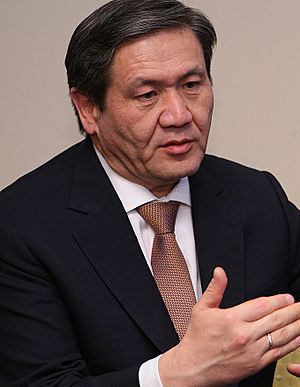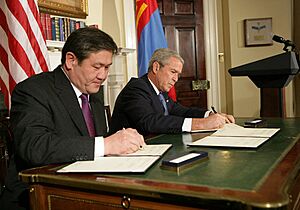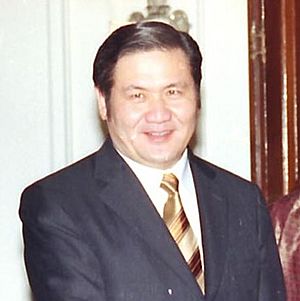Nambaryn Enkhbayar facts for kids
Quick facts for kids
Nambaryn Enkhbayar
|
|
|---|---|
| Намбарын Энхбаяр | |
 |
|
| 3rd President of Mongolia | |
| In office 24 June 2005 – 18 June 2009 |
|
| Prime Minister | Tsakhiagiin Elbegdorj Miyeegombyn Enkhbold Sanjaagiin Bayar |
| Preceded by | Natsagiin Bagabandi |
| Succeeded by | Tsakhiagiin Elbegdorj |
| 21st Prime Minister of Mongolia | |
| In office 26 July 2000 – 20 August 2004 |
|
| President | Natsagiin Bagabandi |
| Preceded by | Rinchinnyamyn Amarjargal |
| Succeeded by | Tsakhiagiin Elbegdorj |
| Chairman of the State Great Khural | |
| In office August 2004 – June 2005 |
|
| Preceded by | Sanjbegz Tömör-Ochir |
| Succeeded by | Tsendiin Nyamdorj |
| Chairman of the Mongolian People's Revolutionary Party | |
| In office 6 June 1997 – 22 November 2005 |
|
| Preceded by | Natsagiin Bagabandi |
| Succeeded by | Miyeegombyn Enkhbold |
| General Secretary of the Mongolian People's Party | |
| In office 5 October 1996 – 7 February 1997 |
|
| Preceded by | Büdragchaagiin Dash-Yondon |
| Succeeded by | Natsagiin Bagabandi |
| Personal details | |
| Born | 1 June 1958 Ulaanbaatar, Mongolia |
| Political party | Mongolian People's Party (-2010), (2021–present) |
| Other political affiliations |
Mongolian People's Revolutionary Party (2010 – 2021) |
| Spouse | Onongiin Tsolmon |
| Children | 4, including Batshugar Enkhbayar |
| Alma mater | Maxim Gorky Literature Institute |

Nambaryn Enkhbayar (Mongolian: Намбарын Энхбаяр; born on June 1, 1958) is a politician from Mongolia. He has held some of the most important jobs in the Mongolian government. He was the Prime Minister of Mongolia from 2000 to 2004. After that, he served as the Chairman of the State Great Khural (which is like the speaker of their parliament) from 2004 to 2005.
Then, he became the President of Mongolia from 2005 to 2009. Nambaryn Enkhbayar is special because he was the first person to hold all three of these top positions in Mongolia. He also led the Mongolian People’s Party from 1997 to 2005. Later, he led the Mongolian People's Revolutionary Party from 2010 to 2021. His oldest son, Batshugar Enkhbayar, is also a member of the Mongolian Parliament.
Contents
Early Life and Learning
Nambaryn Enkhbayar was born in Ulaanbaatar, Mongolia, on June 1, 1958. He finished high school in 1975. He then went to the Maxim Gorky Literature Institute in Moscow, Russia. In 1980, he earned a degree in literature and language studies there.
He also studied English language and literature at Leeds University in the United Kingdom. This was from 1985 to 1986. When he was young, he translated poems by Mongolian poet Mend-Ooyo Gombojav into English. In 1990, Enkhbayar became the head of the Association of Mongolian Writers. He married Onongiin Tsolmon in 1987, and they have four children together.
Starting in Politics
In 1992, Enkhbayar was elected to the State Great Khural. This is the Mongolian Parliament. He was a member of the Mongolian People's Revolutionary Party (MPRP). Mongolia had its first democratic elections, and the MPRP, which used to be the communist party, won.
Enkhbayar was chosen to be the country's Minister of Culture. He held this job until 1996. That year, the Democratic Party won the parliamentary elections. In 1996, Enkhbayar became the secretary general of the MPRP. He led the MPRP group in Parliament, which was then the opposition. In 1997, he was elected as the chairman of the MPRP.
Becoming Prime Minister
In 1999, Mongolia faced a severe natural disaster called a zud. This is when a dry summer and very cold winter blizzards cause huge food shortages. Many thousands of livestock died. The government at the time did not handle the disaster well.
Because of this, the MPRP gained more public support. In 2000, the MPRP won a large majority in the parliamentary elections. They won 72 out of 76 seats. With his party controlling Parliament, Enkhbayar became the Prime Minister of Mongolia.
As Prime Minister, he started a big project called the Millennium Road. This project aimed to build a road connecting Mongolia from east to west. During his time, Mongolia also successfully paid off its debt to the former Soviet Union. This was a big deal because Mongolia had owed money to its northern neighbor since the 1920s. Mongolia's economy also grew a lot, by 10% in 2004. This was partly because the world learned about Mongolia's rich mineral resources.
Leading the Parliament
In 2004, the MPRP lost some seats in the elections. The Motherland Democratic Coalition, which was a group of the Democratic Party and the Motherland Party, gained more power. Neither group had enough votes to form a government alone.
So, a large coalition government was formed. Enkhbayar became the Speaker of the Parliament. He served in this important role from 2004 to 2005.
Serving as President
Enkhbayar won the 2005 Mongolian presidential election and became the President of Mongolia. During his presidency, he welcomed U.S. President George W. Bush to Mongolia. This was a historic event, as it was the first time a U.S. president had visited the country.
Mongolia also received a large amount of aid, US$285 million, from the United States. This was part of the Millennium Challenge Compact (MCC). President George W. Bush and Enkhbayar signed this agreement in 2007.
In the 2009 Mongolian presidential election, President Enkhbayar ran for re-election. However, he was defeated by Tsakhiagiin Elbegdorj of the Democratic Party. Elbegdorj won with 51.21% of the votes, while Enkhbayar received 47.41%. This made Enkhbayar the first Mongolian president to lose a re-election bid.
New Political Party
In 2010, Enkhbayar started a new political party. He named it the Mongolian People's Revolutionary Party. This party was allowed to use the old name of the Mongolian People's Party by the Supreme Court of Mongolia on June 26, 2011. Enkhbayar became the chairman of this new party he created.
Other Interests
Enkhbayar enjoys outdoor activities. On June 23, 2011, he climbed Khüiten Peak. This is the highest mountain in Mongolia. He climbed it with mountaineers from the Mongolian Mountaineering Federation and the Nepal Mountaineering Association.
He is also a follower of Tibetan Buddhism. He has translated several Buddhist texts into the Mongolian language.
See also
 In Spanish: Nambaryn Enjbayar para niños
In Spanish: Nambaryn Enjbayar para niños


